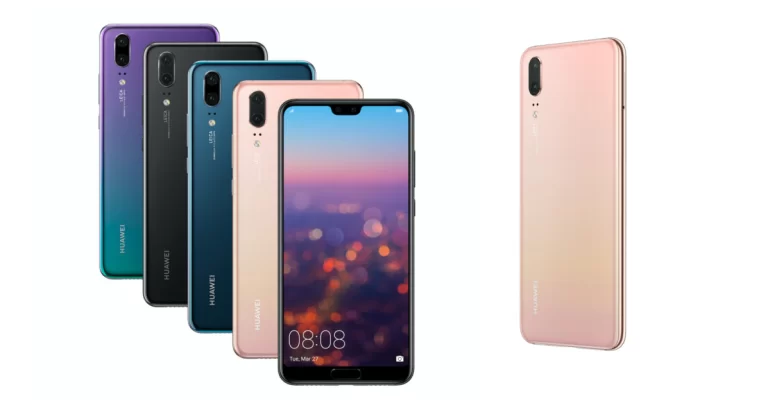there is the Huawei P20 Pro, in my case in black, although it is available in several other colors. Below is a tiny envelope with a transparent TPU cover, apparently of excellent quality, the pin to access the SIM card holder, the warranty card, and the user guide in 21 languages. Below we find the European charger from 5V to 4.5A, USB-C headphones with microphone and volume control, a USB-C to 3.5mm audio jack adapter, and the USB-C high-speed data cable.
Although I wouldn’t say I like that they have removed the 3.5mm audio jack (since it can be uncomfortable to walk with adapters), I must admit that this Huawei P20 Pro comes with all the accessories that we could need. Indeed this is where it makes the difference and distinguishes itself from the rest of the “false” high ranges.
Design and Screen
This Huawei P20 Pro has a careful design with student edges and a glass back. It has a sealed body, so you will not be able to remove the battery, and in case of replacement, you will have to take it to the technical service to be disassembled and replaced.
In addition, it is IP67 certified, so it is waterproof. It will withstand immersion to a depth of one meter for 30 minutes.
The dimensions of this smartphone are 73.9 mm long x 155.0 mm high x 7.8 mm thick, and it weighs only 180 grams. It has a 6.01-inch screen with a Full HD + resolution (1080×2240) and a high concentration of pixels per inch of 432. They are current dimensions, although due to the placement of the fingerprint reader in the lower part of the front, it does not take advantage of the entire surface, reaching a good area of 85%.
The AMOLED type screen is covered with Corning Gorilla Glass 5 protection, where the colors are very vivid and intense. Thanks to the Always-On Display technology, you can configure the screen to always have the time and notifications in view.
From my point of view, it has a perfect quality screen, at the level of a high-end smartphone. With many possible configurations for color and resolution, it implements software that allows the screen resolution to be lowered to HD+, thus saving battery life. As for brightness, other smartphones look better in full sun.
As I said, it has a reasonably sized screen, which, thanks to the “notch,” makes more use of the space. If you don’t like it, you can permanently hide it through the phone settings via software. This notch is the loudspeaker for calls that sounds good, a small multi-color notification LED, the selfie camera, and an ambient light sensor. The fingerprint reader is fast and exact in the lower part of the front. I like the placement of it, although little by little, it will be replaced by sensors on the screen to take more advantage of the surface.
The slot to access the nano SIM card holder is on the left side. On the right is the typical volume up and down button panel followed by the lock button, all made of metal.
On the bottom is the USB Type-C connector with the microphone and speaker on both sides. At the top are the noise-canceling microphone and the infrared LED to use the smartphone as a remote control. It comes with a pre-installed extension from Huawei to be able to use it, but if you are not convinced, in the Google Play application store, you can always download others, whether gratis or paid.
On the left rear, it has a triple camera vertically. Below are the double LED flash and an inscription indicating the collaboration with “Leica.” I want to comment that the first two cameras are joined in a relief that makes it move considerably if you place the Huawei P20 Pro on a flat surface.
In high-end and lower-end models, Huawei always takes special care to maintain a sophisticated design and quality. I like the aesthetics that Huawei provides to its terminals, a point that not all manufacturers consider when manufacturing their smartphones.
Software
This Huawei P20 Pro has the version of Android 8.1 Oreo. However, and for those who choose is for this device, I would like to tell you that the update via OTA of the Android 9.0 Pie version is already arriving, so this next 2019 you will be able to enjoy the latest update. It has the typical customization layer called EMUI in version 8.1 that allows us to configure it to have all the applications on the main screen or an applications menu.
This model is the European version L29, so it has practically all languages, Spanish, Portuguese, French, German, English, etc. It has Google services installed and the Google Play application store, in addition to other brand applications such as Drive, Duo, YouTube, Maps, Photos, etc. As if that were not enough, the Chinese manufacturer (Huawei) has decided to incorporate more applications such as Instagram, Booking, Netflix, Microsoft Translator, and eBay. However, the latter can be uninstalled without any problem. It seems to me very unwise to incorporate advertising so subtly.
EMUI is not a customization layer that I like since, from my point of view, they are not very showy icons. It would be better if they didn’t include so many apps and let the user choose which apps to install. For the rest, Huawei is moving forward with this layer and striving to improve its customization and configuration, achieving greater fluidity.
